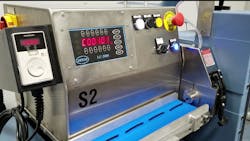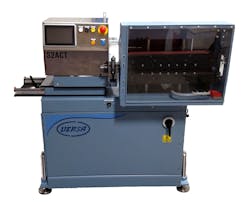Adaptive Cutting System Cuts Tubes, Tools and Time
There are a lot of tasks that we just don’t want to do by hand anymore. Unrolling spooled plastic tubing then cutting it to the correct length is one example. Reflexallen used to have labor and a significant amount of floor space in its manufacturing facility dedicated to unspooling tubing, cutting it to the correct length, then preparing it for further assembly into brake lines, fuel lines and other heavy transportation product. The task consumed production time, storage space and valuable labor. That is until Alessandro Silvestrini determined that with Versa Machinery Adaptive Cutting Technology (ACT), they could cut directly on the extrusion line, saving time, money, and valuable plant floor space.
Versa Machinery makes industry-leading puller assemblies and turnkey puller systems to pull materials downstream. Whether used in a custom-built system or around other purchased components, Versa Puller Assemblies are built to out-perform and outlast, no matter what material is on the line. The Versa Adaptive Cutting Technologies systems were designed to take cutting online, saving storage space and valuable production time for processes and applications just like Reflexallen.
Cutting Down on Space
Reflexallen extrudes nylon tubing used for brake lines, fuel lines, and other products for heavy commercial vehicle market in its Indianapolis, IN plant. It’s a three-step production process: extrusion of the tube, forming the tube, then final assembly where every single tube is formed with the shape that the customer requires and fitted with other components, accessories, clips, etc.
Silvestrini used to use a Versa clutch cutter and spool the coiled tube in batches from 200 up to 1,000 meters at a time in a “work in progress” area. An operator would then pick from the stock of tubing and cut what was needed for production. In addition, three days a week, one operator was tasked with hand cutting tubing for a particular customer/project. The work in progress area took up space on the production floor, hand-cutting was using valuable labor and resulting in a ton of scrap since there was inevitably a length of the tube at the end.
Now, Silvestrini uses a Versa ACT system and cuts online as the tube is extruded. Cutting online presents challenges due to variables associated with the extruding tube. Silvestrini commissioned a Versa cutter with programmed software that could control for extrusion process variables. The result is a consistent cut every time, and labor savings.
The Versa ACT systems are built with the customer and application in mind, with a 1”, 2”, or 3” capacity servo extrusion cutter on a 4” slide base, and a pinch roll, or caterpillar servo-driven puller. A touchscreen interface with built-in length and batch control allows operators to control the cut output. The ACT systems can achieve cutting rates of up to 3,000 cuts/minute and hold cut length tolerance of +/- 0.005” or better, outpacing and outperforming even the most skilled employees armed with scissors.
“Cutting online is ideal because there is no variation in the load. The precision of the cut and the repeatability of the cut are unbeatable,” Silvestrini said.
As an added bonus, cutting online keeps the tubes perfectly straight, rather than the curved banana shape that is inherent when cutting a tube from a coil. Straight tubes are easier to store, ship, and measure. Silvestrini estimates he can fit two to three times more straight tubes than curved tubes in the same box, saving the cost of extra boxes and storage space.
An Endless Recipe Box
The Versa ACT allows Silvestrini to store over 250 part recipe files that hold cut length, line speed, and knife rotational speed. Every time Silvestrini uses the machine, he clears the recipe storage and loads new recipes from a USB stick, ensuring there is no possibility for an operator to pick the wrong recipe. The operator doesn’t have to waste time scrolling through a long list of recipes: he loads what he needs, sets it and forgets it, allowing the machine to run on its own.
Silvestrini can also load multiple recipes in the scheduler, hit play and the machine will cut from one project to the next without stopping or creating scrap. Once started, the machine can run for 24 to 36 hours continuously cutting 25 different lengths in batches. The system also includes the ability to activate optional alarms to tell the operator when it is getting close to completion of a batch and when it has finished each batch.
When the feed approaches the end, the operator simply loads the next batch.
ACT systems feature On-Demand mode, Cam mode, or Flywheel mode cutting from operator entered line speed and cut length figures. On-Demand mode resets the knife to a preset “home position” after every cut for maximum accuracy. Cam mode allows the machine to cut short lengths at full knife velocity without stopping, while Flywheel mode rotates the knife at a constant speed for high cutting rates. The ACT systems with Versa’s exclusive software automatically selects the best mode for the operation of each application.
Production scheduler mode is Reflexallen’s go-to, allowing a long run with no scrap due to changeover. The machine is built specifically for Reflexallen’s needs, with a single servo cutter. Versa also has a different version of the ACT system that can cut double angles. That version includes two servo cutters. One in a fixed position to make 90-deg. cuts and the other being adjustable to cut at any angle from 90 to 45-deg.
“This is gold,” Silvestrini said, “in extrusion, the longer the run the more efficient, the more money you make. You need a machine like this to get the best from your run.”
Setting up the equipment and training employees on the new machine was simple, and took as little as two weeks to get the gear and team up to 100% productivity.
The plant manager is happy, the quality department is happy, and most importantly, the customers are happy. Silvestrini ran a capability study to compare the parts from the old and new processes, and the customers were excited to see the quality and consistency improve.
The ACT freed up facility space by eliminating the “works in progress” storage area, removed the need for hand-cutting thus freeing up an operator for three days a week as well as the operator who would normally cut the spooled product, and doesn’t create scrap during the cutting process, saving material and waste. Silvestrini estimates that the machine paid for itself within nine months.

